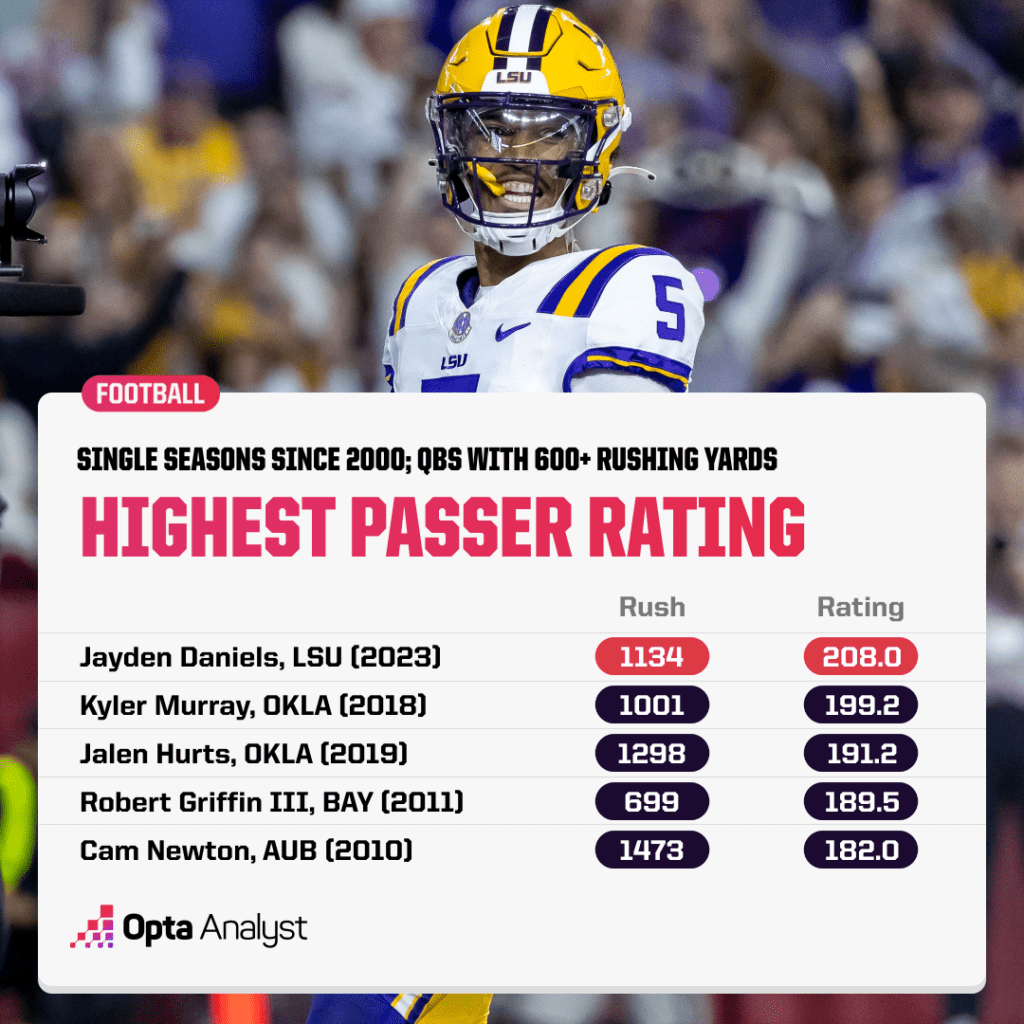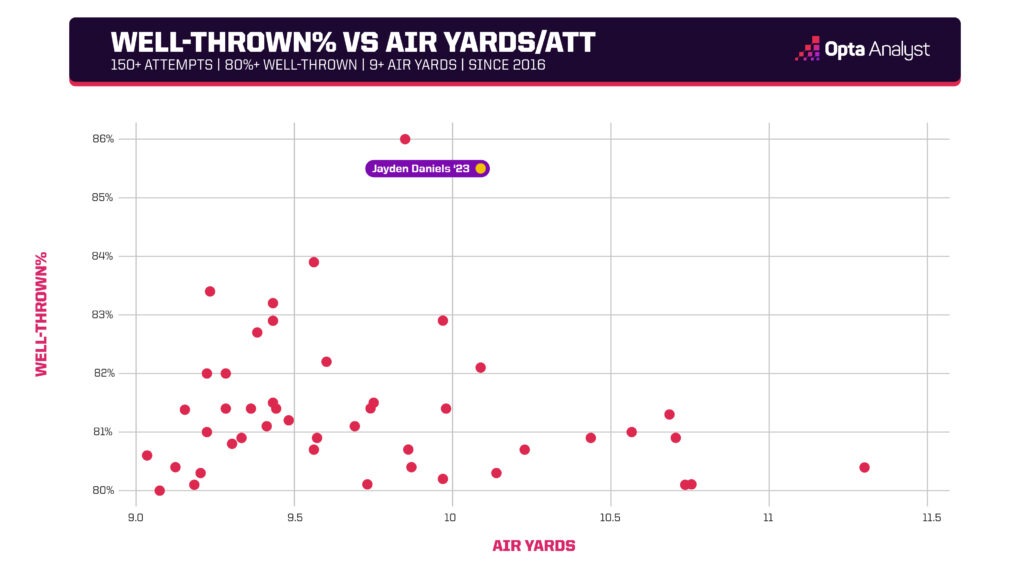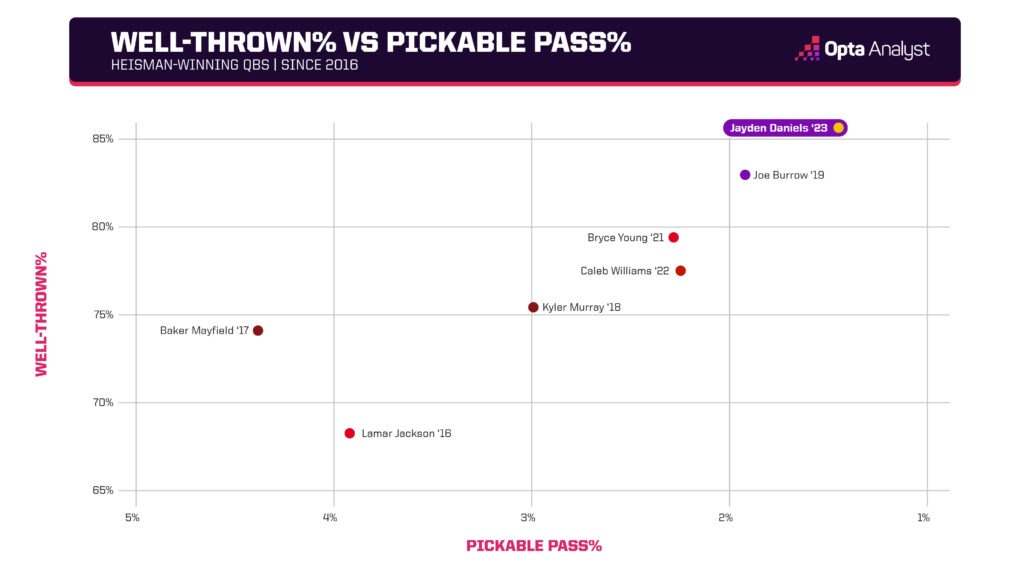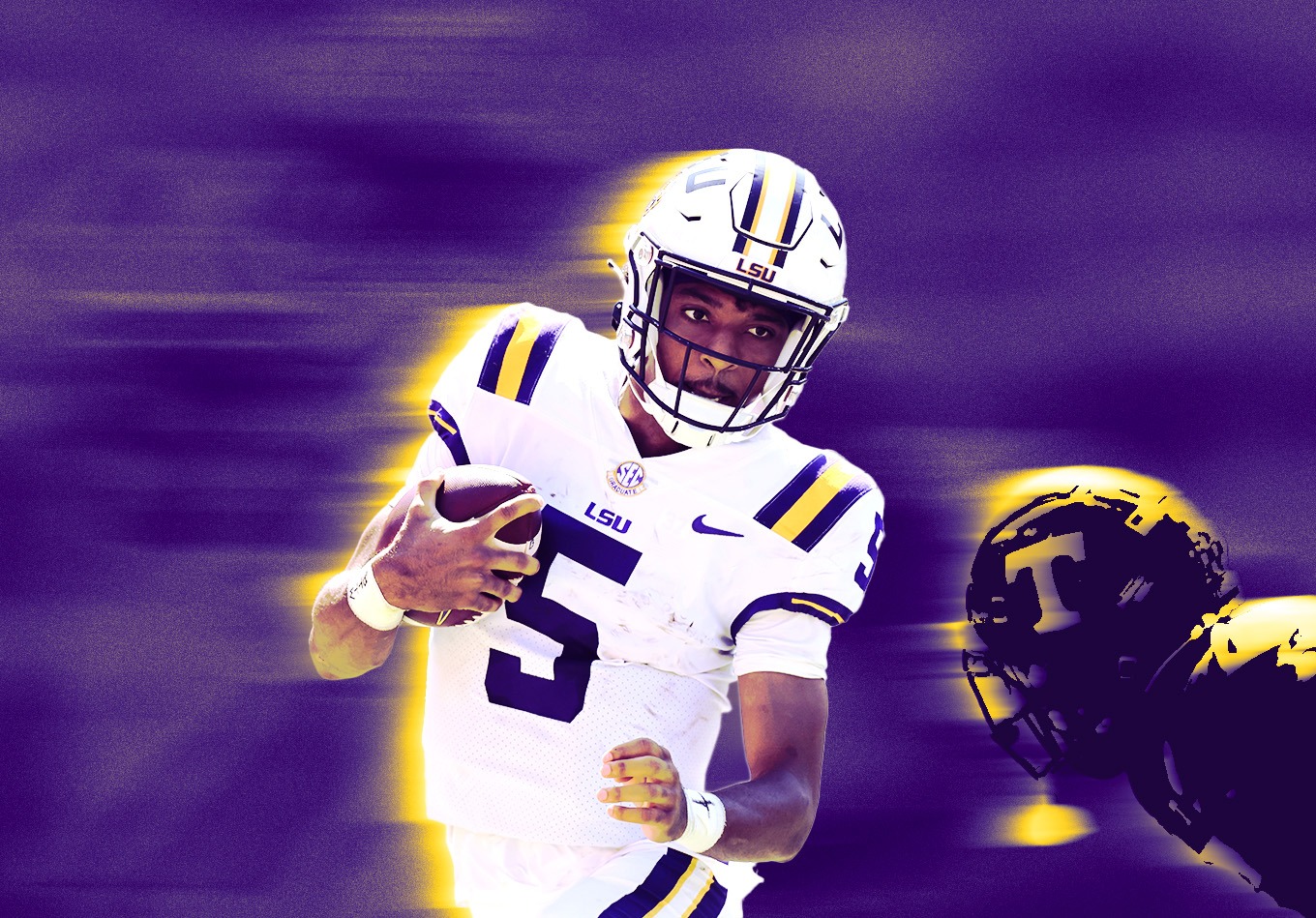When Jayden Daniels won the 88th Heisman Trophy in the history of the sport (89 if you include Reggie Bush’s vacated award in 2005), he cemented himself as immortal in the annals of college football lore.
But how those immortal figures have fared once they reached the professional level has been far from consistent.
At the beginning of the 21st century, the track record of Heisman-winning QBs in the NFL was shaky at best. Chris Weinke, Eric Crouch, Jason White, Matt Leinart, Troy Smith and Tim Tebow were among the “Heisman House” residents who struggled when they reached the NFL, if they got there at all.
But since the start of the 2010s, the Heisman fraternity has seen a notable uptick in professional performance. Lamar Jackson became the first QB in NFL history to win two MVPs before his age-27 season. Joe Burrow remains the last starting QB to beat Patrick Mahomes’ Kansas City Chiefs in a playoff game. Cam Newton won an MVP and started in a Super Bowl, and perhaps Robert Griffin III would’ve been on a similar trajectory if injuries didn’t intervene.
Both Baker Mayfield and Kyler Murray have started in the playoffs and been Pro Bowlers, with Mayfield still standing as the only Browns QB to win a playoff game since the franchise was reinstated in 1999.
Which side will Daniels fall on? Obviously, we won’t know until the 2024 season gets underway. It seems all but a given that the Chicago Bears will select Caleb Williams out of USC with the No. 1 overall pick of the 2024 NFL Draft. But is it really that much of a no-brainer?
Using a combination of conventional stats and advanced metrics, let’s break down how Daniels stacks up to his predecessors, and whether that suggests that pro success is on the horizon.
Record Breaker
Because of LSU’s three losses, Daniels’ 2023 season won’t be remembered the same way as Newton’s 2010 season with Auburn or Burrow’s 2019 with LSU. After all, winning matters. But while Daniels’ year isn’t the greatest of all time in terms of legacy, there’s a legitimate argument that it was the finest college football season ever from a statistical standpoint.
Where to begin? Setting the all-time FBS record in passer efficiency rating is a good start. Daniels’ preposterous value of 208.0 barely edged Coastal Carolina’s Grayson McCall’s 207.6 two years ago, but Daniels more comfortably beat out Alabama’s Mac Jones in 2020 (203.1) for the power conference record.
Consider Daniels’ passing alone, and you already have the most efficient season in the history of the sport. But when you throw his rushing prowess into the mix, the California native becomes an even more absurd outlier, as shown below.

The list of remarkable achievements doesn’t end there. Daniels finished with 11.7 pass yards per attempt in 2023, a full yard ahead of second-place Jason Bean from Kansas. This set a new power conference record, breaking one previously held by Kyler Murray (though McCall has the overall FBS record at 11.9 in 2021).
Speaking of Murray, his 2018 Heisman-winning season used to hold the FBS record for total yards per play – 10.4 – until Daniels put up an astonishing 10.7 this year. (To clarify the difference between these metrics, yards per play entails all passes and rush attempts by any player, including sacks). Indeed, Daniels was nearly as successful on the ground as he was through the air, leading the FBS in both yards per designed run (8.7, min. 50 attempts) and yards per scramble (11.4, min. 25 attempts) in 2023.
Need any more? Via ESPN’s QBR, Daniels’ 95.7 figure in 2023 was the second-best in the metric’s history (since 2004), trailing only Mac Jones in 2020. Via collegefootballdata.com, Daniels led the nation in Expected Points Added last season, roughly 13 points ahead of second-place Bo Nix.
And of course, if it didn’t go without saying, all of this came against a notoriously tough SEC schedule, not to mention a nonconference game against a Florida State team that should have been in the College Football Playoff.
No matter how one slices it, Daniels’ final collegiate season was one for the ages.
Advanced Standout
Still, even with all of these records, it’s an inherent truth in football that not all numbers are created equal. A passer’s efficiency rating and yards per attempt would be equally influenced by a screen pass taken 75 yards to the house as they would be by a perfectly thrown post route that covered the same distance.
Fortunately, we can dive deeper into how Daniels was so productive in 2023, and whether those traits should translate on Sundays.
And when we take such a deep dive, the primary takeaway is one that’s also immediately obvious with a quick glance at his highlight reel: Daniels is no checkdown merchant.
Catchable throw percentage is what it sounds like (how often a throw was deemed catchable, even if it was slightly off target), while well-thrown percentage is strictly based on whether it was deemed to be accurate, even if it wasn’t catchable (such as if a defender batted it away). And no matter what test one uses, Daniels walks away with a stellar score.
There were 132 FBS passers with at least 150 “true” attempts (no spikes/throwaways) in 2023, and Daniels ranked third among them in both catchable throw percentage (83.0) and well-thrown percentage (85.5). If you limit the conversation to the 39 passers who averaged at least 10.0 air yards per attempt, then Daniels vaults to first in both metrics.
In 2023, Daniels was the only FBS passer with at least 10.0 air yards per attempt and a catchable throw percentage of at least 80.0. And if we expand to the entire Opta Analyst tracking data era, Daniels was the only passer to have an 85.0 or better well-thrown percentage while averaging at least 10.0 air yards per attempt since 2016:

Furthermore, the Heisman winner was able to match his accuracy and willingness to stretch the field with a keen ability to avoid poor decisions. Daniels had a stellar 40-to-4 TD/INT ratio in 2023, and this was no fluke.
Our data had a mere 1.5% of Daniels’ attempts being considered “pickable,” which was the third-lowest rate in the nation. In fact, Daniels was the nation’s only passer to average 10 or more air yards per attempt, and have a pickable pass percentage under 2.0 in 2023.
And of course, lest we forget, Daniels did some pretty impressive things on the ground as well. As previously mentioned, he averaged nearly 9 yards per designed run and more than 11 yards per scramble as a senior, numbers which put him in truly unprecedented territory when paired with his passing production.
Among 563 QBs with at least 150 true pass attempts and 25 designed runs in a season since 2016, Daniels was the only one to average at least 8.5 yards per designed run while having a pickable pass percentage under 2.0. Likewise, he became the only player in that span to have at least 8.5 yards per designed run with an 80+ catchable throw percentage.
When under pressure, Daniels ranked third in the nation in well-thrown percentage (84.0) and 11th in pickable pass percentage (2.00). For comparison, Caleb Williams ranked 26th (72.3) in well-thrown percentage and 31st (3.96) in pickable pass percentage.
Whether one looks for accuracy, deep passing touch, decision-making, or mobility, Daniels checks every box from an analytics standpoint.
Heisman Lineage
Circling back, how did Daniels’ season compare to that of other recent Heisman winners?
Spoiler alert: pretty well.
Including Daniels, 20 QBs have won the Heisman Trophy since 2000. Among those 20, here’s how Daniels ranked in several conventional stats:
- Completion percentage: 72.2 (third, behind Joe Burrow and Robert Griffin III)
- Pass yards per attempt: 11.7 (first, also most ever by Heisman winner)
- Total yards per play: 10.7 (first, also FBS record)
- Pass efficiency rating: 208.0 (first, also FBS record)
- Rushing yards: 1,134 (fourth, behind Lamar Jackson, Cam Newton, Johnny Manziel)
To dive into the advanced metrics, we have to limit ourselves to years since 2016, but Daniels continued to excel within that limited group.
The LSU star had the highest well-thrown percentage and the lowest pickable pass percentage among the most recent seven Heisman-winning QBs.

Perhaps more impressive? Even in a group featuring the likes of Lamar Jackson and Kyler Murray, Daniels also led that septet in both yards per designed run and yards per scramble (though, to be fair, Jackson had a far higher volume of rushes than anyone else in the group).
As such, Daniels’ season stood out even when compared to others who have won the game’s most prestigious individual award. But there still could be one Achilles heel that might lead to some skepticism come NFL Draft time.
The Red Flag
To call Daniels a complete late bloomer would be a stretch. After all, his 149.2 passer efficiency rating in 2019 ranked fourth among Power Five freshmen that season (min. 200 attempts), trailing USC’s Kedon Slovis, UNC’s Sam Howell and UCF’s Dillon Gabriel.
His overall stats across his first four seasons – 64.5 completion percentage, 8.0 pass yards per attempt, 49-to-16 TD/INT ratio – were nothing to scoff at.
And in a weird way, it’s this level of production that makes his 2023 surge so unique. We’ve certainly heard of QBs who were relative unknowns entering a season going on to win a Heisman; one even did so at LSU only four years before Daniels.
But in recent years, when a major preseason underdog has won the Heisman Trophy, it’s generally been because that QB was an underclassman (think Lamar Jackson, Jameis Winston, Johnny Manziel), or because that QB barely played in his prior college seasons (think Burrow at Ohio State, or Newton at Florida).
This makes Daniels the ultimate unicorn. Rarely, if ever, has a QB at the college level had a four-year sample size of thorough playing time, and producing at a good but not elite level, before putting everything together for a legendary season.
In modern college football, the closest comparison to Daniels in this regard might be Carson Palmer, who started from USC from 1998-2001 (being limited to three games in 1999 due to a collarbone injury), before returning for a fifth season in 2002 and winning that year’s Heisman Trophy.
Palmer went on to be selected first overall by the Bengals in the ensuing NFL Draft – just like fellow fifth-year senior Heisman winner Joe Burrow 17 years later – before having a quality 15-year career in which he made three Pro Bowls. One could also say Robert Griffin III had a similar career arc to Daniels, though Griffin had been a Second Team All-Big 12 selection behind Brandon Weeden in 2010 before his Heisman season.
This could play out in two ways for Daniels in the eyes of coaches and executives. On one hand, there’s an argument to be made that four years is a bigger sample size than one, and we should treat 2019-22 as a more thorough predictor of Daniels’ potential than 2023. But on the flip side, one could just as easily argue that the 2023 season demonstrated that Daniels is an extremely hard worker and knows how to attack his flaws, personality traits that are helpful to any professional.
Which way will it go for Daniels? We won’t know for a while, though mock drafts tend to be optimistic. Will the Bears shock the world and select him first overall? Probably not. But ultimately, if Daniels’ college production, both based on the eye test and the advanced analytics, is any indication, whichever team calls his name next month will be getting a player with an unmatched blend of skills.
Check out our MLB, NBA and NFL coverage, as well as our college basketball picks. Follow us on X and Instagram for more!
